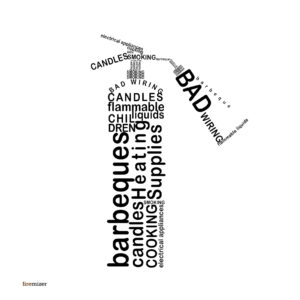How fire safe are you?
What are the different types of fire?
Fires can be separated into 5 different categories depending on the type of fuel. Consequently, for your safety, it is advised to keep a fire extinguisher in your home. Better to be safe than sorry!
As a result, to make sure you have the correct extinguisher look at the 5 fire categories below and decide which rooms you may need an extinguisher.
Getting started with fire extinguishers
Keep at least one extinguisher on each level of your house. Fire extinguishers should be kept in areas where fires are more likely to start, for example in the kitchen and garage.
The five classes of fire extinguishers are – A, B, C, D and F – and each class can put out a different type of fire.

- Class A/ water-based or foam
extinguishers will put out fires from ordinary combustibles such as wood and paper
- Class B/ foam
these are for use on flammable liquids like grease, gasoline and oil
- Class C/ dry powder
extinguishers are suitable for use only on electrically energized fires
- Class D/ specific dry powder
these are designed for use on flammable metals
- Class F
extinguishers are designed for cooking oil fires
How to use your fire extinguisher
Most Fire extinguishers use the P.A.S.S. technique, therefore making them easy to use.
- P. Pull the pin on the fire extinguisher in order to break the tamper seal.
- A. Aim the fire extinguisher low, with the nozzle pointed at the base of the fire.
- S. Squeeze the handle of the fire extinguisher to release the extinguishing agent.
- S. Sweep the nozzle from side to side while pointed at the base of the fire until it is extinguished.
- If the fire re-ignites, repeat the last 3 steps.
How to treat a minor burn
There are three types of burns: first, second and third-degree. Each is based on the severity of damage to the skin. First-degree is the most minor and third-degree is the most severe.
Do not apply ice to burn or use cotton wool as small fibres can stick.
Treatments for a first-degree burn include:
- soak the wound in cool water for five minutes or longer
- take acetaminophen or ibuprofen for pain relief
- apply lidocaine (anaesthetic) with Aloe Vera gel or cream to soothe the skin
- use an antibiotic ointment and loose gauze to protect the affected area
While fire can be fun and relaxing it is also best to take caution when doing anything that involves fire.
In addition, Firemizer reduces creosote by 57% which is a highly flammable resin that sticks to your flue which will reduce the risk of flue fires.
Reference
http://www.eurofireprotection.com/blog/the-fire-classification-system-in-the-uk/
https://www.nhs.uk/conditions/burns-and-scalds/